If jeans are torn or frayed, they can be sewn up so that the damaged area is completely or almost invisible. You don't have to know how to use a sewing machine to do this. You can carefully and efficiently mask any defects by hand.
In what places do jeans tear and wear out most often?
The reason for damage to the fabric may be its fraying. With prolonged wear, scuffs inevitably appear on clothes. Over time, the fibers can become so thin that they begin to tear, and a hole is formed. Jeans also become unusable as a result of mechanical damage. A person can fall, catch on a nail, or accidentally burn the material.
Scuffs due to long-term use most often occur in the following places:
- between the legs;
- along the bottom edge of the trousers;
- along the edges of the front pockets;
- on my knees.
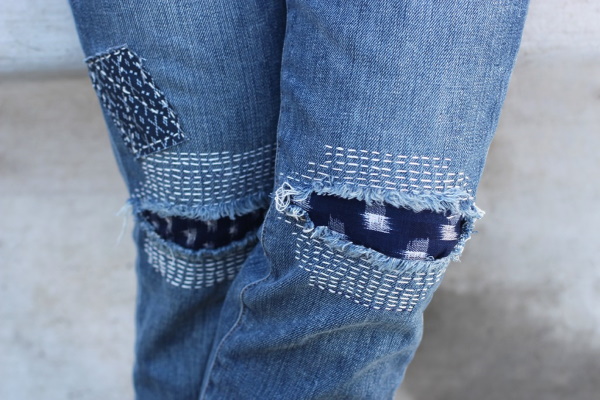
Holes and tears from mechanical damage most often appear on the knees, back pockets, and near the edges of the pockets.
How to mend jeans without a sewing machine?
There are several ways to repair jeans without using a sewing machine. Each of them is chosen depending on the specific place to be repaired, as well as the shape and size of the damage.
Darn
This type of clothing repair involves replacing worn threads of the fabric with new ones. Therefore, for high-quality, neat repair of garments, threads are selected that are as close as possible in color, thickness, and texture. The best option would be to use threads from the same jeans that are to be darned. They can be carefully removed from the folded bottom of the trousers or another inconspicuous place.
If this is not possible, use special darning threads or floss.
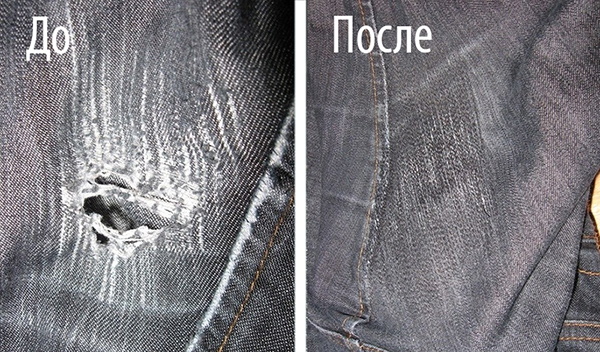
Darning is suitable for restoring heavily worn fabric that begins to "glow". Most often, such damage occurs between the legs, as a result of friction when walking. You can also darn a small hole with torn edges. In this case, a patch is placed on the back side, which is sewn along the edges or glued with an iron.
Plastering
In cases where it is necessary to connect the edges of the fabric invisibly, a patch is used. This repair option is suitable if the jeans were cut by something sharp or torn by a nail. This method can also be used to patch up a through hole that has a round or irregular shape.
Stitching is the most common technique for repairing jeans. There are several types of stitching that allow you to eliminate the most common damage to denim.
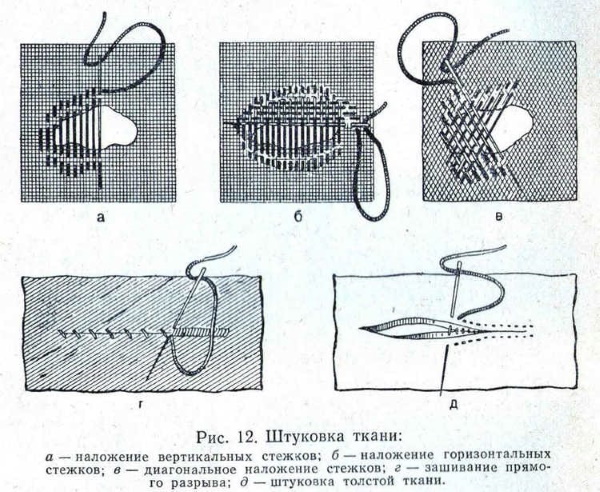
Examples:
- Overlaying stitches vertically.
- Overlaying stitches horizontally.
- Overlaying stitches diagonally.
- Dense stitching over overstitched edges.
- Stitching thick fabric from the front to the back without piercing the fabric all the way through.
Blind stitch
You can also sew up jeans by hand without being noticed using a blind stitch. This method is usually used if the trousers are ripped along the seam. For example, the seam may come apart on the buttocks or sides. It is not uncommon for some sewn-on detail to come off: a belt or a patch pocket.
If this is the only defect, not accompanied by abrasions and deterioration of the canvas itself, then a hidden seam will help to completely eliminate the damage, leaving no traces of repair.
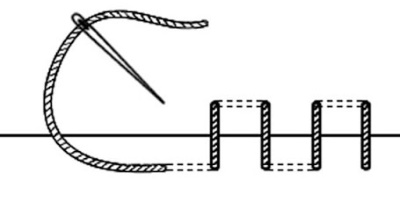
This technique is also used in cases where it is necessary to hem the bottom of the trousers. The need for this action may arise for various reasons: restoration of worn edges, fixing the hem from the inside, or processing the bottom after shortening jeans.
Technique for manually patching a round hole
To seal a round through hole, you need to prepare the following tools and materials:
- a piece of denim fabric of the same color as the item being repaired;
- threads of matching color;
- needle;
- scissors;
- iron.
The work to eliminate the hole is carried out in the following order:
- Cut a patch from the scrap that is larger in diameter than the hole.
- Place the patch face down on the back of the jeans and sew around the circumference with a small stitch, no more than 1 mm on the front side. If possible, try not to pierce the fabric all the way through, but to grab individual threads from the surface of the back side.
- Place the torn area with the patch sewn on it on a hard surface, slightly stretching the fabric. The right side of the jeans should be on top, and the patch should be on the bottom.
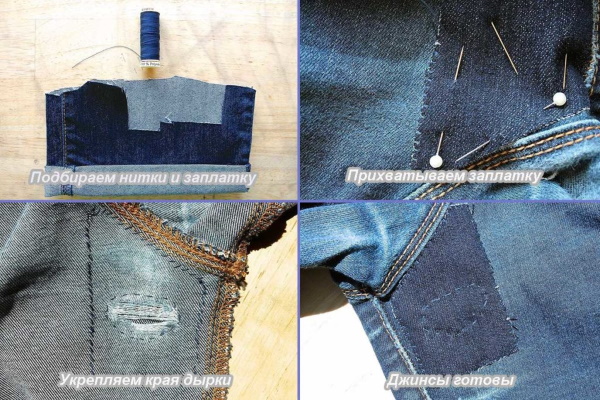
- From the front side of the hole, make frequent parallel stitches along the grain line. The entry and exit points of the needle should be at some distance from the edge of the hole, in undamaged areas of the material. To avoid pulling the edges together, make a small loop at the end of each row.
- After the entire hole has been closed with long longitudinal stitches, the same stitches should be made in the transverse direction, intertwining them with the threads of the first row.
- It is necessary to take into account the direction of the weave of the threads on the fabric being restored. In the case of diagonal weave, the stitches should also be laid diagonally.
- After completing the repair, you should iron the repaired area first from the back side and then from the front side.
Technique for patching a hole with an angle
It is possible to sew jeans unnoticeably by hand for various types of damage by choosing the appropriate restoration technique.
For example, in case of complex angular ruptures, repairs are carried out as follows:
- Place the damaged area of the item on a hard surface.
- Carefully iron the reverse side of the tear.
- Pull the edges together with a thin basting thread. Start with the shorter side of the corner, then sew the second, longer side.
- Each direction of the rupture is sutured with a “needle stitch”, starting, as in the previous operation, from the shorter line.
- Sew the processed sides of the corner with an over-edge stitch.
- Iron through a damp cloth.
Technique for sealing a burnt hole
A hole burned by a cigarette or a spark from an open fire source is usually small in size, has a round shape and characteristic dark scorch marks along the edges. The repair method should be chosen based on these features. Repairing round holes was discussed above.
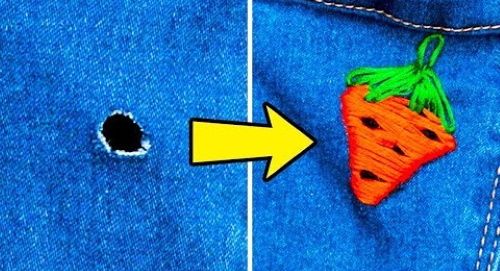
However, if the hole is very small and does not exceed 2–3 mm in diameter, it can be carefully sewn up with thick threads, pulling the edges together. If the patching is done in the manner described above, the scorched edges of the hole should be treated first. The scorch marks are cut off with scissors, and then the edge of the hole is folded to the wrong side and hemmed.
Technique for repairing a tear without a patch
A patch is not required if a blind seam is used for repair. To lay a neat and unnoticeable blind seam, you will need to follow the steps described below in sequence.
Technique:
- Insert the needle and thread randomly into the fabric from the inside and bring it out to the front, leaving a knot in the fold of the fabric on the back side.
- Connect the edges of the tear by inserting the needle at a distance of 4–5 mm from the edge.
- Make a straight stitch, bringing the needle and thread to the front side.
- Repeat this action until the tear line is completely closed. The thread should be slightly pulled after each stitch during work.
- At the end of the work, secure the thread by threading it through the loop and pulling it lightly.
How to sew up a hole between the legs by hand?
Holes and severe abrasions in the crotch area of jeans are the most common damage that occurs during the use of the item. To fix the damage, you need to cut a patch from the same fabric as the jeans. You can use the lower part of the trousers left after shortening.

If this is not possible, the fabric that is most suitable in color and density is selected. The patch is sewn to the trousers turned inside out. The color of the threads is also selected to match the fabric. The direction of the grain threads on the patch and jeans should match.
From the front side, the repaired area is stitched in a zigzag pattern in the forward-backward direction. This technique and compliance with all the nuances allows the damage to be made almost invisible.
How to sew up a hole in your butt by hand?
The choice of method for restoring jeans in the buttocks area depends on the nature of the damage. A hole with torn edges can be repaired using the stitching method described earlier. Since the defect may be in a fairly noticeable place that catches the eye, it is better not to sew the patch to the inside, but to attach it with an adhesive base. This will help to avoid possible protruding thickening of the fabric.
If your jeans have ripped at the seam or are torn along the seam, you should use a blind stitch.
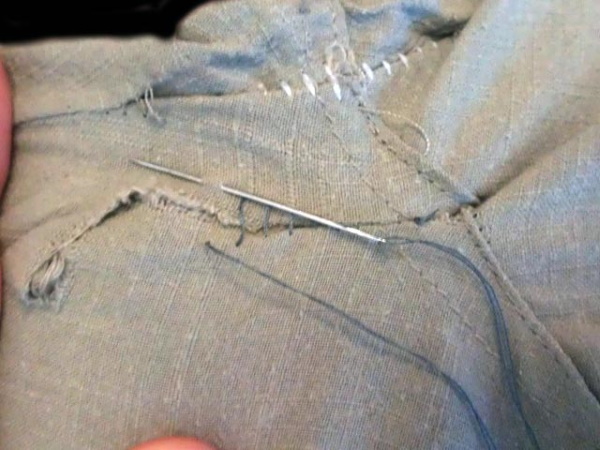
Finally, the hole on the bottom can be decorated with an applique or a fake pocket. When choosing decorative elements, it is important to observe the measure and focus on the age, gender and lifestyle of the person who will wear the item.
How to sew up a hole on your knee with your hands?
It is impossible to sew jeans at the knee so that it is not noticeable. However, for lovers of handicrafts, in this case there are many opportunities to show creative imagination.
Below are some of the most obvious options for decorating a hole in the knee:
- Contrasting color denim patch.
- A patch made of printed fabric of a different type and texture.
- Contrasting decorative darning.
- Application.
- Leather patch.
Decorative patches can be sewn on the front side or peek out from a hole on the back side. They can be made on both knees, symmetrically, or only on one.
How to sew up a hole in a pocket?
It is probably easier to disguise holes in jeans pockets than in any other place. Pockets are traditionally decorated with stitching, embroidery, appliques, and stripes.
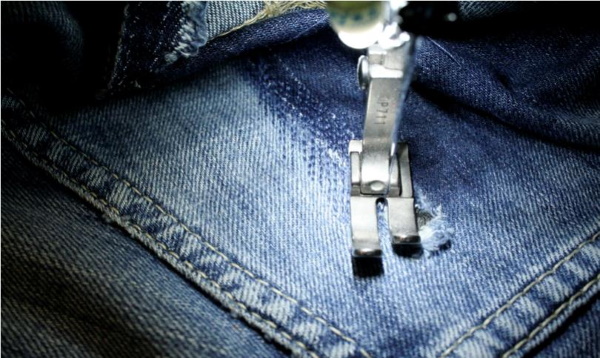
A small hole can be hidden by sewing an applique over it or embroidering an image with satin stitch, wool or silk floss. A contrasting or monochrome artistic darning laid over the patch will hide the hole perfectly.
How to sew near the pocket?
The characteristic holes in the corners of pockets are formed when the pockets are constantly pulled down. This happens when some bulky items (for example, a wallet or keys) are constantly carried in the pockets. If a person is used to keeping his hands in his pockets, they can also begin to wear out and tear quite quickly.
The method of mending holes near pockets depends on their size. If the hole is barely noticeable and is close to the edge of the pocket, it can be sewn with a seam "over the edge". If there are larger holes, the edge of the pocket should be ripped off. Then the hole is darned or patched in the usual way, after which the pocket is returned to its place.
What to do with worn out jeans bottom?
The worn-out bottom of the trousers should be repaired in the following order:
- iron the folded areas;
- use scissors to cut off any frayed threads and/or the entire bottom edge if it is very worn;
- sew a trouser tape of a suitable color to the front side;
- fold the ribbon inward and sew it on the wrong side;
- iron with a hot iron;
- if desired, add a finishing stitch.
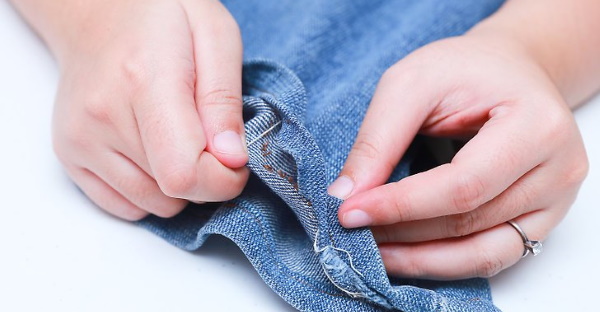
Another way to get rid of worn bottoms is to cut off the legs completely or in half, turning the jeans into shorts or breeches.
Options for decorating holes (lace, fabric, leather, embroidery, etc.)
Sewing jeans by hand without being noticed is not always the best idea for repair. As mentioned above, holes that spoil the appearance of the item can be “played up” and turned into a fashionable exclusive highlight.
The decor options depend entirely on the taste, preferences, skills and creative courage of the master.
Almost any materials, decor and accessories are suitable for transforming jeans, combining the functions of repair and decoration:
- lace;
- textile;
- leather;
- embroidery threads;
- applique;
- rhinestones;
- sequins;
- beads;
- beads.
Large holes on the knees or pockets of women's jeans can be decorated with lace or guipure. If the lace insert is supposed to be on the front side, the threads should match its color. If the lace is sewn on the back side, the threads are matched to the color of the denim. An almost universal way to repair children's or teenage jeans is applique.
It can be sewn on or in the form of a heat-sealed sticker. A single applique is used to mask a hole in a pocket or knee. However, you can sew many similar decorative elements of various shapes and sizes on different parts of the trousers. A thing decorated in this way will look cheerful and bold; it will allow the teenager to stand out among his peers, which is very important at this age.

Below are some different creative patch ideas for different damaged areas.
| Material and idea | Patch location |
| Embroidery in the form of a monster with a mouth in place of the hole. | Knees, back pockets. |
| The patch is a fabric flower with a bead in the center. | Any place on the front of the trousers from top to bottom. |
| The patch is a heart made of printed fabric, sewn on the reverse side. | Front side of trousers, back pockets. |
| Embroidery in the form of an animal head using satin stitch. | Near any pockets: the animal seems to be looking out of the pocket. |
How to hand sew or glue a patch?
Methods for sewing on patches without using a sewing machine were discussed above.
There are several types of patches used to restore jeans:
- consignment note;
- insertable;
- double-sided;
- decorative.
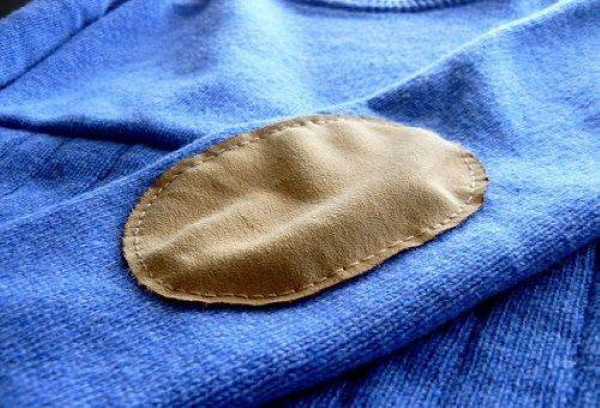
The patch can not only be sewn on, but also glued using interlining.
If you don't have any adhesive fabric at hand, you can use another method of gluing the patch using:
- shoe glue;
- means for gluing rhinestones;
- rubber glue;
- furniture glue;
- adhesive for layer-by-layer bonding of fabric.
If your jeans are too worn out to be repaired, don't throw them away. The fabric can be used to manually repair other items by cutting out patches or pulling out matching threads.
Video on how to mend a hole in jeans
How to sew up a hole in jeans between the legs:
https://youtu.be/l_clbeXb3Sc
